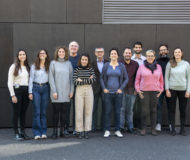

A new study has identified a promising therapeutic pathway to restore the ability of HDL lipoproteins to remove cholesterol from vascular smooth muscle cells (VSMCs), which are involved in the development of atherosclerosis. The research was led by scientists from the CIBER of Diabetes and Associated Metabolic Diseases (CIBERDEM), the Sant Pau Research Institute (IR Sant Pau), and the Clinical Biochemistry Department of Sant Pau Hospital in Barcelona.
Vascular smooth muscle cells can transform into foam cells during the atherosclerotic process, making up as much as 70% of this cell type within the arterial plaque. These cells lose their ability to efficiently remove cholesterol, which contributes to the progression of cardiovascular disease.
The study, published in the journal Biomedicine & Pharmacotherapy and led by Joan Carles Escolà-Gil, Francisco Blanco-Vaca, and Marina Canyelles, demonstrates that pharmacological activation of the Liver X Receptor (LXR) allows the lost ability of VSMCs to release cholesterol to be restored. This promotes its transport to fecal excretion.
The researchers used an experimental drug that activates the LXR receptor. When administered to cholesterol-loaded VSMCs, it significantly increased the transport of cholesterol to HDL in the blood, the liver, and finally to the feces.
Acyl-CoA cholesterol acyltransferase (known as ACAT) is an enzyme that converts free cholesterol into esterified cholesterol for storage within the cells. Under normal conditions, this prevents excessive accumulation of free cholesterol. However, in foam cells, this action contributes to the retention of cholesterol within the cell. Inhibiting this enzyme prevents cholesterol from being stored, facilitating its elimination from the body. In this study, the drug that activates LXR was combined with another drug that inhibits the ACAT enzyme, which further enhanced this process.
“The results indicate that the transition of VSMCs into foam cells significantly impairs their ability to expel cholesterol. However, this function can be restored by activating the LXR receptor, which opens new opportunities to reduce cholesterol buildup in the arterial wall,” highlights Dr. Carla Borràs, first author of the study and researcher at IR Sant Pau and CIBERDEM.
For his part, Dr. Joan Carles Escolà, one of the study’s directors, points out that “the combination of drugs that activate the LXR receptor with ACAT inhibitors could represent a new synergistic therapeutic strategy to slow the progression of atherosclerosis, although it will be necessary to develop delivery vehicles that can specifically target these treatments to foam cells.”
Researchers from the CIBER of Cardiovascular Diseases (CIBERCV), the Institute of Biomedical Research of Barcelona, and the CSIC also participated in the study.
Carla Borràs, Noemí Rotllan, Raquel Griñán, David Santos, Arnau Solé, Chen Dong, Qi Zhao, Vicenta Llorente-Cortes, Marta Mourín, Begoña Soto, Mercedes Camacho, Mireia Tondo, Marina Canyelles, Francisco Blanco-Vaca, Joan Carles Escolà-Gil. Restoring cholesterol efflux in vascular smooth muscle cells transitioning into foam cells through Liver X receptor activation. Biomedicine & Pharmacotherapy, 2025, Volume 188, 118178, https://doi.org/10.1016/j.biopha.2025.118178